► CAR lives with a Supra
► Ben Barry is a big fan
► Will living with one change that?
If Toyota’s Gazoo Racing product roll-out is a sports-day relay race, the GR Supra has charged from the start to just a cheer from its mum, only to pass the baton to the GR Yaris so it can triumphantly break through the finish tape. There’s no doubt the little hatch has stolen the sport car’s thunder, so it seemed appropriate to compare the two as our Supra gives way to a new arrival, the Yaris GR.
The Supra fields a longitudinal six-cylinder engine and auto transmission with a classic rear-drive/two-seat layout. The Yaris mounts half as many cylinders transversely in the engine bay, comes with a manual gearbox, and stuffs all-wheel drive into a compact hatchback body.
It’s not just the specs that are poles apart. Where the Supra reaped economies of scale with partner BMW, the Yaris is brilliantly – and perhaps puzzlingly – bespoke. No other Yaris uses a three-door bodyshell, nor all-wheel drive, and even its roof is lower. Distant echoes of Audi Sport Quattro and Impreza 22B here, a welcome throwback given the clock is ticking on this stuff.
James Taylor is running the Yaris, and as I take my final drive in the Supra to meet him, it reaffirms how much I’ve bonded with the coupe. The driving position is low-set perfection, I love the smoothness, flexibility and sophistication of the straight-six, and it’s been a great long-distance companion, though lockdown has capped mileage.
CAR lives with a Toyota GR Yaris
The Supra isn’t perfect – I’ve said before that I thought a different example I drove had more traction, the steering is numb, and the rear suspension travel can be abruptly checked on trickier surfaces. I’d be tempted to mod the chassis – but, that said, get into a flow through a series of quick third- to sixth-gear corners and you’ll wonder why the Supra hasn’t fared better in tests.
Its front-end bite, strong brakes, keenness to turn and throttle adjustability are all big plus points. It’s a shame we don’t get the more powerful US spec, but rarely has it left me wishing it had more than 335bhp. Had lockdown not condemned it to mostly shorter trips, I’m sure I’d have seen 32mpg.
The Yaris might look sensational, and has brilliant seats with tactile suedey centres, but it gets off to a bad start with a bar-stool driving position. Everything gets better from here. The 257bhp three-pot turbo immediately feels energetic and flexible, with perky throttle response – it’s clear that the Supra has more muscle when James scoots off ahead, but the Yaris doesn’t lag so far behind (at 1280kg to the Supra’s 1495kg, it’s down 24bhp and 40lb ft in the power-to-weight stakes), and I’m astonished at how keen and revvy it feels, quite unlike the usual three-cylinder econo-motors that wheeze and thrash at peak revs. This thing wants you to wring its neck and always feels pokey, though I’d prefer a less artificial soundtrack.
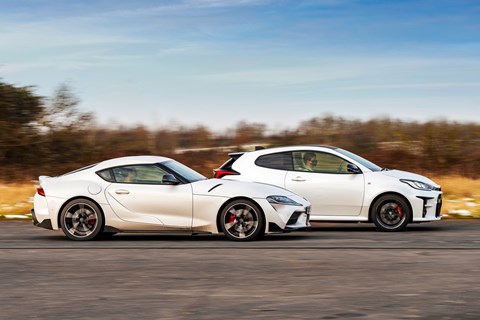
Cutting over B-roads, the Yaris quickly reveals its dynamic character, helped by this car’s optional Circuit Pack, with uprated suspension. The ride is firm and connected, if with plenty more compliance than my old Renault Megane RS Trophy, the steering light, pacey and more feelsome than the Supra, the brake feel reassuringly meatier too (the front discs are actually bigger than big brother’s), and the gearshift precise enough if no match for Civic Type R perfection. The pedals aren’t ideally spaced, but you can heel-and-toe no problem.
It takes a little longer to dig into the chassis on these wintry roads, even if early signs are encouraging. Select Sport mode and you get a 30/70 front-to-rear torque split, but in tighter corners it just feels pleasingly rear-biased and understeer-resistant while soaking up all the performance.
The Supra is quite traction-limited in similar corners, so it’d probably find a little Yaris looking pretty big in its mirrors, especially in less than ideal conditions.
The Yaris’s playful side emerges in quicker turns, where the chassis offers the kind of bung-it-in adjustability of the best front-drive hot hatches – childish fun, yes, but also key to a fluid dynamic that lets you optimise your line through corners. Then it marries that with the throttle-steerability of rear-biased all-wheel drive – a sensation that the rear tyres are really driving the car out of the bend that was always the reserve of larger all-wheel-drive machinery with longitudinal engines until the Mk3 Focus RS re-wrote the rules.
Add all this together and the Yaris GR is both a proper little bundle of fun and a serious and mechanical feeling bit of kit. I’ll miss the Supra, but the Yaris’s blend of entertainment, practicality and affordability makes it the car I’d sooner own.
By Ben Barry
Logbook: Toyota GR Supra
Price £54,340 (£55,050 as tested)
Performance 2998cc turbocharged six-cylinder, 335bhp, 4.3sec 0-62mph, 155mph (limited)
Efficiency 34.4mpg (official), 25.3mpg (tested), 188g/km CO2
Energy cost 21.1p per mile
Miles this month 1056
Total miles 5212
Month 5 living with a Toyota Supra: working the angles

I couldn’t resist asking photographer Jordan Butters to grab this shot when we were both working on something else at the Lotus test track. Toyota has been supplying engines to Lotus for years, so it’s a bit ironic that I’m at Lotus driving a Toyota with an engine borrowed from BMW.
No matter, the 3.0-litre turbocharged straight-six is cracking, so smooth and sophisticated, eager to boost from barely idle speed but with the reward of a more purposeful howl and linear acceleration at higher revs that’s often missing from turbo engines.
You can easily tune these engines for more than the standard claimed 335bhp (which is often pessimistic anyway), but only if you’ve jumped out of a supercar does it feel lacking. The B58 unit is also more than capable of returning 30mpg-plus, though some enthusiasm is knocking that at the minute.
Playing around on track also confirms that you need quick hands to catch a sliding Supra – much as I enjoy how eagerly its front end swings into corners and how flamboyantly rear-biased it feels, it can take on big angles pretty quickly.
By Ben Barry
Logbook: Toyota GR Supra
Price £54,340 (£55,050 as tested)
Performance 2998cc turbocharged six-cylinder, 335bhp, 4.3sec 0-62mph, 155mph (limited)
Efficiency 34.4mpg (official), 27.4mpg (tested), 188g/km CO2
Energy cost 18.8p per mile
Miles this month 713
Total miles 4156
Month 4 living with a Toyota Supra: what can’t it do?

Complaining that a Supra isn’t very practical is like complaining a sportsbike is too windy, so I won’t go on about its two seats limiting how much a family man like myself can use it. But recently it proved perfectly useable for several two-hour trips to and from Brands Hatch for the final two race weekends of the EnduroKa season.
The Supra’s a good long-distance cruiser, and it’s doing high-20s mpg despite significant enthusiasm on post-race drives home. And, thanks to a seat that slides back a long way, I was able to use it to change into my fire-retardent race gear. Who needs a motorhome?
By Ben Barry
Logbook: Toyota GR Supra
Price £54,340 (£55,050 as tested)
Performance 2998cc turbocharged six-cylinder, 335bhp, 4.3sec 0-62mph, 155mph (limited)
Efficiency 34.4mpg (official), 28.4mpg (tested), 188g/km CO2
Energy cost 17.5p per mile
Miles this month 679
Total miles 3443
Month 3 living with a Toyota Supra: visiting the ghost of Christmas future
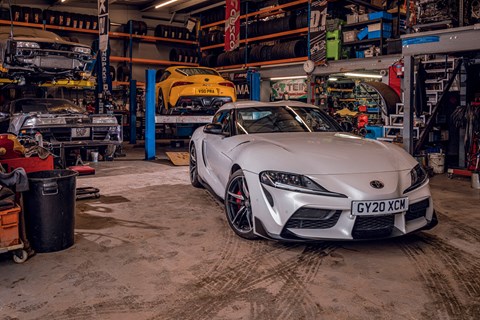
AE86, 2JZ, S15, RB26, Sil80… if this sounds like an internet error code, you probably shouldn’t visit Garage-D, and if you do, you might be asked to leave. Based in converted farm buildings outside Watford, Garage-D is run by Julian Smith and specialises in drift and track preparation, most notably rear-drive Japanese cars to which those alphanumeric codes relate, though he’s also a BMW man.
I’ve known Julian for over 15 years, in which time he’s worked on my M3, lost none of his Kiwi-tinged Irish accent, and – more famously – prepared cars for the Fast & Furious films. He’s built a reputation partly on his talent for thinking outside the box like an old-school rally mechanic – he could probably rebuild a 2JZ Supra motor with a cable tie and a spanner from a Christmas cracker if he had to – but Julian’s also a highly accomplished driver.
He’s most associated with the ’90s/early-noughties peak of Japanese high performance including Mk4 Supras, S-body Nissans and R32-34 Skylines. But more recently he’s been investigating tuning options for the new BMW-based Mk5 Supra.
Read our full Toyota Supra review
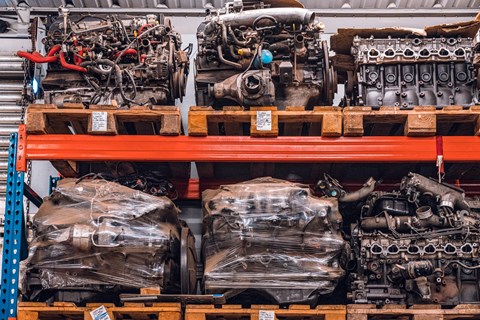
He asked if I’d like to bring the CAR Supra down for a comparison with a tuned example owned by customer Duncan Lang, the yellow car in these pictures. Mk4 Supra owners generally arrive in a Gold’s Gym T-shirt doing a rolling burnout, but the Mk5 is clearly attracting a different crowd if Duncan is representative. He’s enjoyed a long career working in project management for car makers and major suppliers, including ensuring Renault Sport and Ford RS/ST models were equipped with seats.
Duncan was at Garage-D within weeks of getting his new Toyota. ‘I liked the Supra, but it could feel quite strangled, as though there was a restriction in the exhaust, and it perhaps wasn’t as exciting as I hoped,’ he sums up.
The first step was to treat the 3.0-litre straight-six turbo engine to a stage 1 ECU re-map. The stock baseline was recorded at 355bhp on what’s described as an independent and conservative rolling road. The re-map wasn’t immediately straightforward, as it transpired the third-party software had been written for US cars, but with some fine tuning it eventually recorded 402bhp – more than the 377bhp upgrade announced for US Supras in 2020 (if without the US models’ lower-compression pistons and six-port exhaust manifold).
More recently Duncan’s Supra has gone to a stage 2 ECU tune. Induction is standard, but there’s a new de-cat HKS exhaust that still works with the active flap in the driver’s-side exhaust outlet. An issue with the dyno means a reliable horsepower figure hasn’t yet been recorded, but subjectively I can tell you: IT’S LOTS.
Much as I’m interested in the power upgrade, the conservative chassis upgrades on Duncan’s car are actually more intriguing; as I noted last month, our Supra seems to have much less traction than the car I first drove, and slides both early and very quickly.
Turns out the US cars have had suspension updates, but there’s evidence online of alignment inconsistencies on Euro-spec cars, and Garage-D found Duncan’s example less than ideal. They’ve adjusted toe and camber to compensate and give the rear tyres more contact patch while cornering, but this car is also on Tein lowering springs, which drop the car 25mm at the front and 20mm at the rear. Running small wheel spacers, the result’s subtle, but does give the Supra a more purposeful stance.
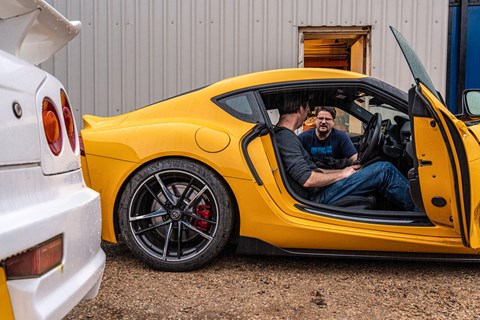
Duncan kindly offers me a drive. I fire up his car and the HKS exhaust erupts like a fireworks display. It certainly gives the Supra a stronger voice, but the pops on the overrun make it sound like you’re misbehaving even when really you’re not. I’d pass.
I like the power upgrade, though – the throttle response feels much more urgent, and there’s more oomph brewing immediately under your right foot when you accelerate, as well as a far stronger and richer top end, where the stock car runs out of puff. It feels so much more potent even when you go steady that I’d guess at 450bhp.
It’s bucketing it down during my drive, so I never feel comfortable lighting it up and punching in shifts with the throttle pinned, but apparently the shift strategy for the eight-speed auto is more aggressive in Sport, and puts a bigger gap between Sport and Comfort.
The differences to the chassis are quite pronounced. Fitting lowering springs can often destroy ride quality, but these Tein springs might actually have improved it. Yes it feels firmer in some ways, but Duncan’s Supra doesn’t seem to suffer the abrupt checks at the rear on the rebound that the standard car sometimes does. It also feels more consistent when I carve into a roundabout off-throttle, as though the front and rear ends are better connected and the way it loses grip (within the confines of the fully activated stability control, given the conditions) is more progressive – though the alignment adjustments are all bundled up in this change of feel.
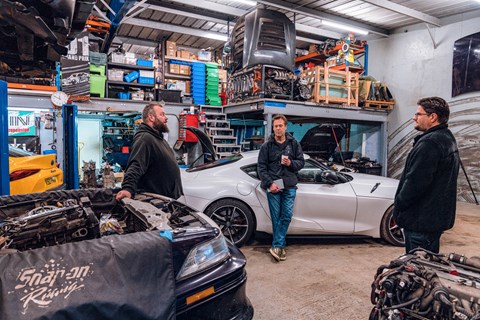
If I had to choose from all these mods, I’d play about with the chassis first, and it’s interesting that just changing the alignment could make a big impact, without actually modifying any of the standard parts at all.
Knowing Garage-D, though, this is just the first step on a journey that’ll one day lead to a full-house track car to rival the 800bhp Mk4 monster he has tucked away. Whatever Julian does, it’ll be well worth watching out for.
By Ben Barry
Logbook: Toyota GR Supra Pro
Price £54,340 (£55,050 as tested)
Performance 2998cc turbocharged six-cylinder, 335bhp, 4.3sec 0-62mph, 155mph
Efficiency 34.4mpg (official), 29.3mpg (tested), 188g/km CO2
Energy cost 17.4p per mile
Miles this month 825
Total miles 2764
Month 2 living with a Toyota Supra: it can be comfy too

I think this new Toyota Supra’s a great motorway car. I know, that sounds a bit damning for a sports car, but it’s because it feels so planted when you’re cracking on. It’s satisfying in a way I can’t quite pinpoint just yet, although it’s something to do with the swell of torque always available from the silky BMW turbo six.
I always default to the softer damper setting, even when I’ve got the steering and powertrain in perkier Sport (press start, select gear, press Sport, it’s ingrained now), because the stiffer damper mode is a bit spiky.
You sit slightly recumbent in the low-set driving position (comfy enough, though my back’s had enough after two hours). Road noise would creep in from the unseparated rear luggage area, but I tend to crank up the stereo to cover it up. My car’s spec includes 12-speaker JBL Audio.
It’s not just about laid-back, stereo-up motorway driving, though. I also particularly enjoy squirting along quick third- and fourth-gear twisty roads – that planted feel again, the smooth performance, how eagerly it changes direction and the accurate, pacey steering. I’d like more feel to that steering (make that some steering feel) and crisper gearshifts, and I can see there’s room for extra dynamic sparkle on more technical roads, but I always enjoy the Toyota.
For a while I thought this car had less traction than the last new-generation Supra I drove. Tyre tread on the Michelin Pilot Super Sports is still very healthy, but the car was sliding early and quickly – short wheelbase, decent torque – in a softish sort of way. I adapted by not flattening the throttle quickly, more feeding it in like I’m dosing an infant on Calpol. And then I checked the pressures. They’re at 30psi, down from the minimum 32psi recommended and I presume they’ve been that way while I’ve had it, seeing as the tyre-pressure monitoring hasn’t blinked. Time for some higher pressures and a bit of experimentation, I think.
By Ben Barry
Logbook: Toyota GR Supra Pro
Price £54,340 (£55,050 as tested)
Performance 2998cc turbocharged six-cylinder, 335bhp, 4.3sec 0-62mph, 155mph
Efficiency 34.4mpg (official), 30.5mpg (tested), 188g/km CO2
Energy cost 16.7p per mile
Miles this month 1143
Total miles 1979
Month 1 living with a Toyota Supra: hello and welcome
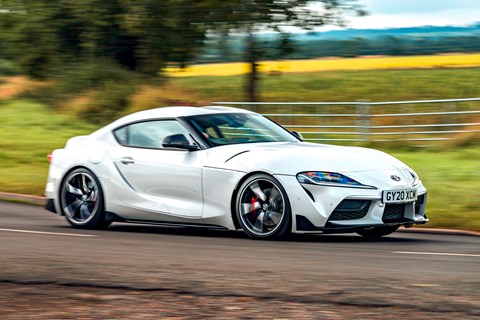
There’s so much irresponsibility to mentally sift through but ultimately there are two images that leap out when I think Toyota Supra, both Mk4-related. The first is Kazuhiko ‘Smokey’ Nagata, owner of Top Secret, a Japanese tuning house. Smokey brought his 1000bhp Supra to the UK in the late 1990s, hit 197mph on a straight stretch of the A1 (M) in the dead of night, before attending a Cambridgeshire police station and being sent back home.
The second was a pre-YouTube video of a lemon yellow Supra from Japanese tuners Jun, drifting a fast, dry corner on a circuit. It came into shot towing a cloud of tyre smoke and exited with a trebly wail that swirled howling turbo and screeching tyres into one nails-on-blackboard cacophony. I never knew cars could do this on a sealed surface.
The Mk4 ended production in 2002 but still has a strong following (sought-after UK-spec cars are advertised for £40k-£50k), and a fanbase that kept the faith for 17 whole years before the Mk5 arrived. So when a long-term loan became a possibility, that long wait and all that residual fondness meant I put my hand up for the keys like an over-eager pupil desperate to answer a question. I now have six months to resist driving like a lunatic in an Initial D comic.
While key tenets of the Supra philosophy remain the same, namely a turbocharged straight-six engine and rear-drive layout, more is different about this all-new generation – especially as the Mk5 is based on the BMW Z4 platform, and built at the same Magna Steyr production facility in Austria.
Read our BMW Z4 long-term test
So not only are the powertrain, suspension hardware and electronic systems carried over from the BMW, but so too is the infotainment and switchgear – you select Drive (this time the Supra is automatic only) on a BMW shifter, and twirl an iDrive rotary controller to select your radio station and nav destination. The interior even smells distinctly BMW. This seems strange at first, like opening your front door but walking into someone else’s house. Equally, though, I’d rather use BMW infotainment than Toyota’s.
For all the commonality, Toyota has been free to take this car in its own direction, with Tetsuya Tada (the engineer behind the GT86) leading development and giving the Supra his own distinctive signature. Not forgetting that the Supra is available only as a coupe, the Z4 only as a cabriolet – the only bespoke small sports car BMW makes and it lets Toyota do the more sporting version!
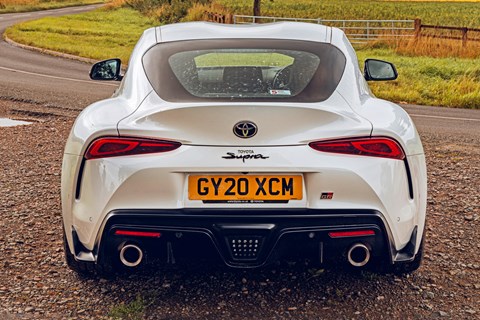
More than the platform, the bigger mental block for me was performance. The Mk4 Supra went head-to-head with the R34 Nissan Skyline GT-R, so I was sceptical on first hearing the Supra would produce 335bhp – comparable to the last of the UK models sold two decades earlier and far short of the now-ancient R35 GT-R’s 562bhp.
But then the new Supra is also £31k cheaper than the £84,035 Nissan GT-R, and this is a more compact Supra than its predecessor – 131mm shorter overall and with a wheelbase 80mm shorter, which has played a useful part in keeping the weight down to a comparable 1495kg despite two decades of safety kit and technology added in.
The latest Supra GR (for Gazoo Racing, the umbrella for all Toyota racing exploits/racey road cars) comes in either entry-level or Pro trims. Our car is a Pro, which costs £54,340 and adds wireless phone charging, head-up display, 12-speaker JBL audio, full leather (standard is alcantara and leather) and a luggage net to an already strong standard spec.
Considering that Pro is but a £1305 premium, it’s hard to imagine Toyota selling any entry-level Supras at all. Refreshingly, the only option added to our car is £710 for metallic white paint. It leaves the final tally at £55,050.
When I first drove the new Supra last year, I said I’d happily own one. This long-term loan will be the acid test.
Our Supra’s spec details
Fully loaded
Our car gets the top-spec Pro trim (the launch-special A90 Edition was limited to 90 units). It adds just £1305 to the price, but comes with a stack of extra kit, including 12-speaker JBL audio and full leather. The only other option on our car is £710 of metallic white paint.
BMW for collab
Just like it did for the GT86, Toyota has teamed up with another manufacturer for the Supra – this time BMW. But unlike the Toyota GT86/Subaru BRZ, there’s more than just badge engineering – the two cars look completely different, and only the Supra is a coupe.
Sawn-off dimensions
BMW 3.0-litre straight six with a twin-scroll single turbocharger gives 335bhp and 369lb ft torque. Eight-speed auto is standard, as are adaptive dampers. Wheelbase is shorter than the more junior GT86; the Supra has two seats, where the GT86 is a 2+2.
Logbook: Toyota GR Supra Pro
Price £54,340 (£55,050 as tested)
Performance 2998cc turbo straight-six, 335bhp, 4.3sec 0-62mph, 155mph
Efficiency 34.4mpg (official), 33.5mpg (tested), 188g/km CO2
Energy cost 15.5p per mile
Miles this month 352
Total miles 836